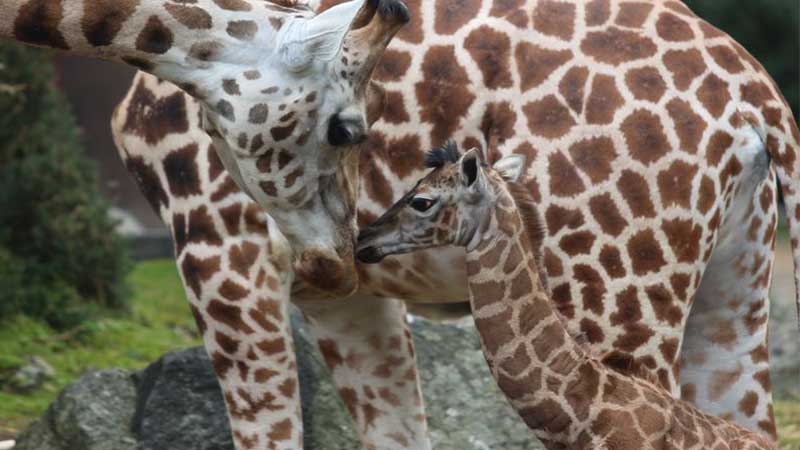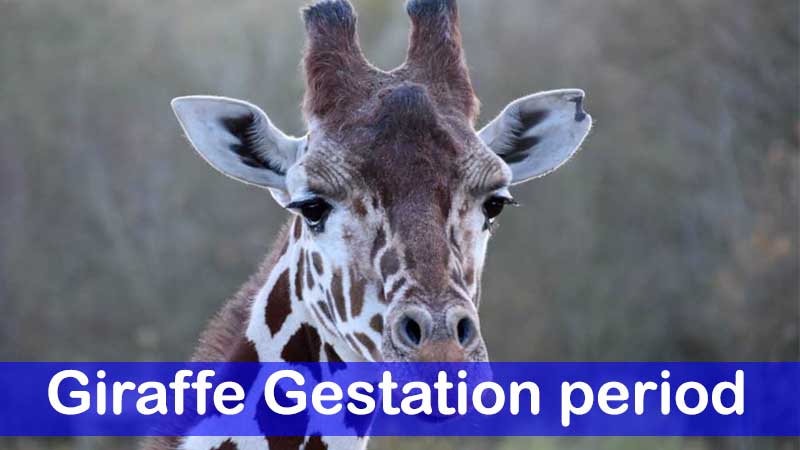It is simply impossible to miss the imagery of a giraffe’s towering presence, long neck and graceful stride. These poised, slow-moving animals all possess unique markings on their skin and trot in little families across African savannahs, leaving every person amazed at nature. However, beneath this facade lie many breathtaking biological marvels.
One of these is the Giraffe Gestation Period which outlines their remarkable reproductive journey. It’s impressive to see how tall giraffes manage to get pregnant and give birth so easily.
This blog will expound more on giraffe pregnancies as well as their gestation periods, stages of fetal development and factors that affect both the mother and her calf welfare-wise. Let us demystify the mystery surrounding the giraffe reproduction that makes them even more fascinating creatures.
Giraffe Gestation Period
The Giraffe Gestation Period is an amazing phenomenon that highlights the awesome reproductive process of these majestic animals. Among mammals, it is one of the lengthiest lasting for about fifteen months. During this long period, the mother giraffe or cow experiences vast changes physically in order to give care to and defend her growing baby.
In order to have a well grown calf before coming out, this long gestation period is necessary. Nevertheless, despite their seemingly towering presence, they demonstrate incredible grace in undergoing pregnancy and birthing processes. At this time she receives care from her herd mates thus ensuring her security and health.
This blog post shall zoom into details regarding reproduction among giraffes by taking you through fetal development stages; unique adaptations for carrying pregnancy in giraffes as well as factors that affect both maternal and offspring health. Let’s unravel the enigma behind giraffe pregnancies with a view to understanding them better and appreciating these great creatures’ incredible journey towards parenthood.

Different Stages of Giraffe’s Pregnancy
For about fifteen months, a giraffe goes through pregnancy which has various stages. The start of this process is with fertilization after the mating of the female giraffe and male which results in an implanted egg in her uterus.
Cell division and differentiation are happening fast during the embryonic period therefore creating a foundation for calf’s development. As a result, a developing fetus develops quickly with limbs, muscles and skeletal structures appearing.
The mother’s body undergoes various adaptations throughout this time in order to support its growing fetus resulting to hormonal changes for nutrient delivery. In its last months, the calf continues to develop and the mother may exhibit nesting behavior indicating that she is ready for birth.
After approximately 15 months, the mother giraffe gives birth with assistance from her herd thereby welcoming the newborn giraffe into the world.
From one stage of giraffe pregnancy to another one, there is an incredible process that allows these animals to reproduce themselves and thrive within their natural environments at all times
How Often Do Giraffes Reproduce?
Compared to many other mammals, giraffes reproduce very few times in a lifetime before giving birth to one calf that has been carried for 15 months. After a calf is born, cows usually wait for at least one or two years before they mate again.
The time period between these births enables the mother giraffe to spend sufficient time and resources with her young ones hence ensuring survival of the species in the challenging savannah habitats.
Moreover, their long gestation periods and inter-birth intervals ensure population control of giraffes as well as sustaining ecological equilibrium within their biotopes. When it comes to reproduction timing in giraffe herds, various factors such as food availability, environmental conditions and social dynamics must be considered.
On balance, this low rate of reproduction by giraffes contributes to its distinct life history strategy which shows how well adapted it is under difficult conditions in its natural habitat.
Giraffe’s Reproductive Behavior
Reproductive behavior among giraffes is very interesting and it depends upon both biological and social factors. Bulls, the male members of this species, do courtship displays to attract females during the mating season which is a year-long affair with peaks in some regions that coincide with the rainy months. This often involves bouts of necking when a bull uses its lengthy neck to fight rivals so as to prove its dominance and secure breeding rights. After that, mating takes only seconds or minutes.

In comparison to small and docile ones, female giraffes are selective about their partners hence opting for larger and more aggressive bulls. However, there might be some attempts on the part of females who have no interest in these suitors such as kicking them or running away from them. Then she will have a gestation period that lasts for about 15 months before delivering one calf.
Moreover, other reproductive linked social behaviors can be seen in giraffe herds. Bull giraffes might form hierarchies of dominance among themselves while bulls may seek females for mating and thus establish dominance.
The reproduction behavior of giraffes is a complicated intermingling between biological instincts, societal changes, and external factors that depict these animals’ adjustment to an African savanna.
How Long Does the Labor Last in Giraffe?
Giraffes spend about 1-2 hours in labor from the start of contractions to when the calf is born, but this duration may be influenced by such factors as the healthiness of the mother, and the positioning of the baby, as well as environmental conditions.
Giraffes give birth by standing on their feet and first come out are hooves followed by head and body. Licking and nudging its newborn is another way of helping it take breaths easily since its circulation will too increase courtesy of that lick from her mother.
Despite their enormous height, giraffes have a relatively fast labor compared to other mammals. With this brief process, predators do not have enough time to prey on them unlike many others; hence both survive.
Factors Influencing Giraffe Gestation Periods
The gestation period of giraffes, which is an average of 15 months, is influenced by several factors. In the first place, genetics are involved because there are different lengths in gestation for various individual giraffes and subspecies.
The mother’s health and condition can be affected by her food availability as well as quality; these factors may influence how long she remains pregnant before giving birth. The dominant females among the herd could have a shorter period of pregnancy since they are able to access the resources best, unlike other animals.
Other stressors such as climate change, habitat loss or human disturbance also cause reproductive health problems that affect the length of the gestation cycle. In summary, variations in giraffe’s gestation periods can be said to be due to combined genetic, environmental and societal reasons; therefore this shows how intricate their reproduction biology is.
5 Facts About Giraffe Gestation Period and Pregnancy
A Long Pregnancy: Giraffe reproduction takes around 15 months, one of the longest for terrestrial mammals, granting a large period of time for calf growth.
They have only one baby at a time: A number of ungulate species can produce twins when they give birth; however, giraffes are usually single-calf pregnancies.
Delivery while standing: Although in some cases it may be very rare to see such calves as twins, the young ones are born from this position.
Fast Delivery: Giraffes require about an hour or two to deliver, which is quite short due to their long gestation period hence limiting exposure to danger.
Mothers after delivery: After giving birth, the mother giraffe immediately starts licking her newborn and within a few hours the calf can stand and nurse while showcasing remarkable motherly instincts.
FAQs About Giraffe Gestation
Why does the pregnancy of a giraffe take longer than other mammals?
The long gestation period is believed to be an adaptation for giraffes’ ecosystem confrontations, to ensure that calving seasons fall during times of abundance.
How does pregnancy affect a female giraffe over its extended duration?
To meet the nutritional needs of an enlarging fetus, pregnant giraffes alter their behavior constantly during the course of their pregnancies by searching for areas with high food content productivity.
Do different giraffe species take differing amounts of time for their calves to develop inside them?
Yes, there can be slight variations in gestation periods among different types of giraffes but they normally last between 15 months.
What is the male’s role during pregnancy for giraffes?
Male giraffes generally have no input into pregnancy and childcare; rather, it is mainly limited to mating only.
Are young giraffes born with a similar hide design as adult ones?
Giraffe babies have a similar hide design like those of grown-ups. However, their spots may darken and transform with age.
Summing Up
The savannah of Africa is vast. It is home to the majestic giraffe that captivates people with its towering height, graceful movement and characteristic skin patterns. However, there is an amazing world lying behind this imposing beauty, which includes how giraffes do it.
The giraffe’s reproductive process is shown to be very adaptable and tough in its 15 month gestation period. The birth of a giraffe from the moment it is conceived until it is delivered shows the miracles of nature; in order to carry and protect the growing calf, a female giraffe undergoes major physical change.
We have shown various stages in giraffe pregnancy through this blog considering them as different adaptations, social behaviors as well as environmental factors shaping their journey of giving birth.
In our quest to unravel the mysteries surrounding reproduction by these wonderful creatures, we gain more insight into them and their extraordinary journey towards parenthood providing better knowledge on what they really mean for an ecosystem.

